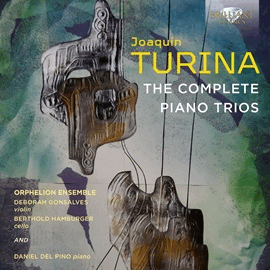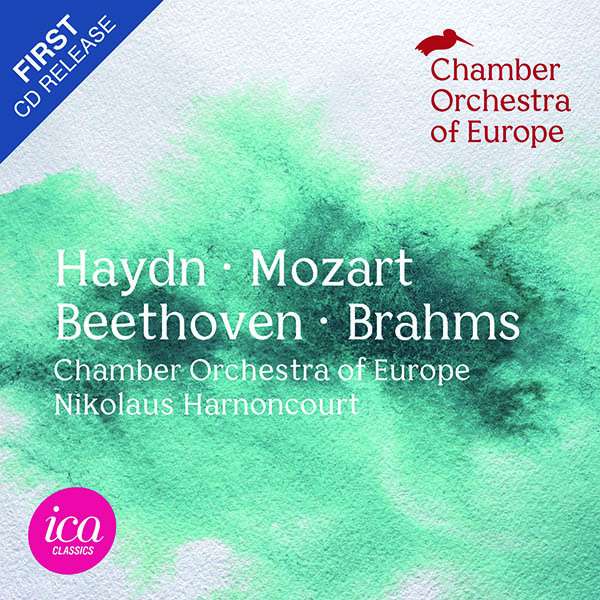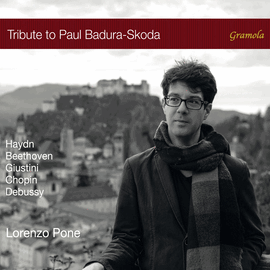 Joseph Haydn: Symphonien Nr. 100 & 101; Wolfgang Amadeus Mozart: Symphonie Nr. 29 + Serenade Nr. 9, Posthorn, Marsch Nr. 1 KV 335; Ludwig van Beethoven: Symphonien Nr. 5 & 7; Johannes Brahms: Symphonie Nr. 4 + Tragische Ouvertüre op. 81; Chamber Orchestra of Europe, Nikolaus Harnoncourt; 4 CDs ICA Classics ICAC5161; Liveaufnahmen 1989-2007, Veröffentlichung 05.11.2021 (260'3) - Rezension von Remy Franck
Joseph Haydn: Symphonien Nr. 100 & 101; Wolfgang Amadeus Mozart: Symphonie Nr. 29 + Serenade Nr. 9, Posthorn, Marsch Nr. 1 KV 335; Ludwig van Beethoven: Symphonien Nr. 5 & 7; Johannes Brahms: Symphonie Nr. 4 + Tragische Ouvertüre op. 81; Chamber Orchestra of Europe, Nikolaus Harnoncourt; 4 CDs ICA Classics ICAC5161; Liveaufnahmen 1989-2007, Veröffentlichung 05.11.2021 (260'3) - Rezension von Remy Franck
Mit Liveaufnahmen aus Amsterdam, Graz und Berlin hat ICA Classics ein Viereralbum gefüllt, das Nikolaus Harnoncourt als Haydn- Mozart-, Beethoven- und Brahms-Interpret zeigt.
In den beiden Pariser Symphonien erweist er sich als brillant inspirierter Dirigent, der das Militärische in der 100. Symphonie ebenso deutlich werden lässt wie das Uhrticken in der Symphonie Nr. 101. Das Chamber Orchestra of Europe sorgt für einen extrem lebendigen, überaus farbigen und reich akzentuierten, sehr rhetorischen Klang von großer Spontaneität und Frische.
Nicht weniger spannend sind die Mozart-Aufnahmen der 2. CD, wobei vor allem die Posthorn-Serenade gefällt: sie ist nervig, gespannt, klar, durchhörbar und klingt bei aller Intensität doch noch elegant.
Die beiden Beethoven-Symphonie Nr. 5 und 7 sind in guten, aber keineswegs außergewöhnlichen Interpretationen zu hören. Die Tempi sind rapide und die gesamte Anlage recht frisch. Der zweite Satz der Siebten sticht dabei etwas heraus.
Die beiden Brahms-Interpretationen bestätigen eigentlich das, was ich immer bei Harnoncourt und Brahms fühlte: Sein streckenweise (aber wirklich auch nur streckenweise) sehr persönliches, sehr eigenwilliges Brahms-Bild hat keine Kohärenz. Meines Erachtens ist das das große Manko des Harnoncourt-Brahms. Er hat kein schlüssiges Konzept, er weiß nicht so richtig, was er eigentlich sagen will. Da gibt es wunderbar lyrische Passagen und andere, wo der Dirigent kräftig zupackt und einen wirklich spannungsvollen, mitreißenden Klang produzieren lässt, doch es gibt weitaus mehr, das statisch und langweilig ist. Und selbst dort, wo Harnoncourt versucht, etwas mehr Dramatik in die Musik zu bringen, ist das ein sich auf dem Platz-Bewegen, kein Vorwärtsdringen, kein dem Ende Zustreben, wie es Brahms braucht. Hie und da sind langsame Passagen schwülstig verzuckert und es gibt auch immer wieder Stellen, wo sich der Dirigent sehr manieriert gibt. Da lässt er dann phrasieren, dass man glaubt, auf der Achterbahn zu sein, oder auf einem Schiff, bei hohem Seegang! Dieser Brahms hält nirgends zusammen.
Und so ist dieses Album mit sehr gutem Haydn- und Mozart, mittelmäßigem Beethoven und höchst diskutablem Brahms keine besonders gelungene Hommage an den Dirigenten. Statt Brahms wäre Dvorak besser gewesen, denn Harnoncourt war einer der begnadetsten Dvorak-Dirigenten des 20. Jahrhunderts.
With live recordings from Amsterdam, Graz and Berlin, ICA Classics has filled a four-album set that shows Nikolaus Harnoncourt as an interpreter of Haydn, Mozart, Beethoven and Brahms.
The two Paris symphonies show him as a brilliantly inspired conductor who makes the military character of the 100th Symphony as clear as the clock ticking in Symphony No. 101, and the Chamber Orchestra of Europe provides an extremely lively, exceedingly colorful and richly accented, highly rhetorical sound of great spontaneity and freshness.
The Mozart recordings on the 2nd CD are no less exciting, and the Posthorn Serenade is particularly pleasing: it is nervy, tense, clear, listenable, and yet still sounds elegant for all its intensity.
The two Beethoven symphonies, Nos. 5 and 7, are heard in good but by no means exceptional interpretations. Tempi are rapid and the overall approach quite fresh. The second movement of the Seventh stands out somewhat.
The two Brahms interpretations actually confirm what I have always felt about Harnoncourt and Brahms: his sometimes very personal, very idiosyncratic Brahms image has no coherence. In my opinion, this is the great shortcoming of the Harnoncourt Brahms. He has no coherent concept, he doesn’t really know what he wants to say. There are wonderfully lyrical passages and others where the conductor lets the orchestra produce a really exciting, stirring sound, but there is far more that is static and boring. And even where Harnoncourt tries to bring a bit more drama to the music, it’s a moving-in-place, no striving toward the end as Brahms needs. Here and there, slow passages are sugar-coated and there are also passages where the conductor is very mannered. There he lets phrasing that one believes to be on a roller coaster, or on a ship, with a high swell! This Brahms does not hold together anywhere.
And so, with very good Haydn and Mozart, mediocre Beethoven and highly debatable Brahms, this album is not a particularly successful tribute to the conductor. Instead of Brahms, Dvorak would have been better, because Harnoncourt was one of the most gifted Dvorak conductors of the 20th century.



















